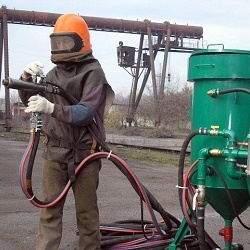How to run a chainsaw
A chainsaw can be a great helper for working with wood. However, not many people know that the first hours of operation of the unit require the implementation of certain rules of running. Running in a chainsaw is a process required for both a new and a tool after an overhaul. Beginners who have never had experience with a chainsaw need to approach this process responsibly. It should be noted that even if an incompetent seller asserts about the optional sawing procedure, it is still recommended to familiarize yourself with the instructions attached to it and this article before the first start.
Content
Why running is necessary
Properly run in a chainsaw is necessary in order to ensure the durability and trouble-free operation of its elements. The fact is that the main engine of the chainsaw is a two-stroke gasoline internal combustion engine. All its elements and components are installed by the manufacturer without lapping to each other. Since even the most accurate and important detail has its own error tolerancethen it is running in qualitatively and reliably perform the most accurate fit of all rubbing mechanisms and their parts.

A major overhaul is comparable to the first launch of a new unit, so after it the chainsaw must also go through a mandatory running-in procedure.
One of the most important moments of this procedure is oil selection. It is this lubricant that forms the necessary film, which is a guarantee of long trouble-free operation. The oil must be chosen in accordance with the instruction manual, which most often recommends products designed specifically for two-stroke gasoline engines. One of the best proven oils for this technique are:
- NANOPROTEC 2T SUPER;
- LIQUI MOLY;
- MOBIL.
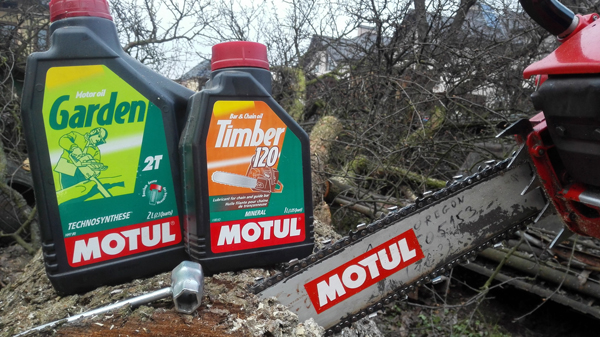
This product contains specially developed additives in its arsenal, thanks to which the engine of a chainsaw starts more easily and is lubricated better at any time of the year.After all, it is known that mineral lubricating materials at negative temperatures tend to turn into a very thick texture, similar to jelly. The main thing that it was original oil, therefore, each chainsaw owner must beware of fakes. It is better to pour synthetic or, in extreme cases, semi-synthetic oil labeled "2T". If the instruction manual of a separate rare model contains recommendations for the use of a particular brand of oil, then it is worth listening to it.
Starting a new chainsaw
It is worthwhile to approach the first launch of a new or repaired saw with the utmost responsibility, while observing the precise actions of this step-by-step instruction. First of all, it is necessary to prepare the fuel. For chainsaws, namely for their two-stroke internal combustion engine, a special mixture is prepared consisting of gasoline and oil. The octane number of the fuel should not exceed 90, in exceptional cases, this value can be increased - this recommendation is described in the instructions for a particular saw model. In this case, the use of gasoline stored for more than 2 months is prohibited,since during long-term storage natural causes of gum formation may begin, which will inevitably lead to fouling of the combustion chamber with carbon deposits typical for this. The proportion is also regulated by the manufacturer and averages around 1:40 or 1:50. This means that about 1.20–0.30 grams of oil should be added per liter of gasoline. Having thus prepared the fuel, we fill the tank.
If the engine is repaired, it is also recommended to check and clean the special channels on the working tire of the chainsaw to be started and lubricate the drive sprocket additionally.
Sam start the engine as follows.
- Set the chain brake in the lock (non-working) condition. This is done by retracting the brake lever.
- Close the air inlet flap.
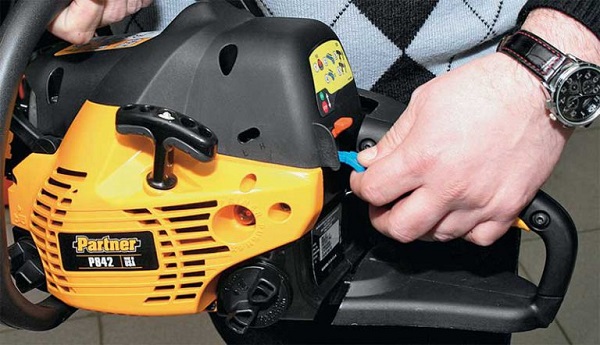
- Switch on ignition.
- If the chainsaw has decompression valve, then it must be pressed to make it easier to start.
- After fixing the saw, with the free hand, the starter handle is taken and tightened until it engages with the drum mechanism, and only then a sharp confident jerk of the starter is made. This procedure several times until the first flash in the combustion chamber occurs, and a saw for a second or two will start and stall.Only after that the valve is placed in its original open position, and restart is performed, which should be crowned with success.
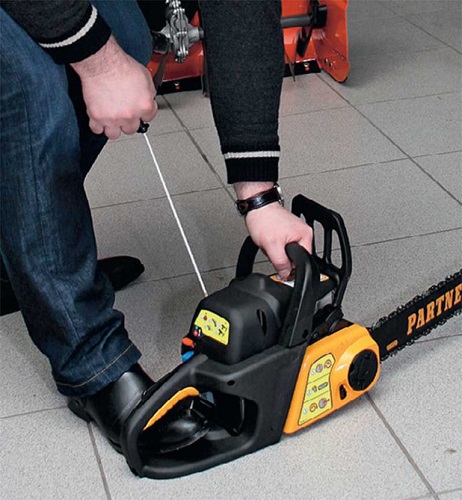
- When the engine is started, it is pressed to the handle or the button to increase the speed (progazovki) to full gas and released for stable operation at idle.
Features of running the engine chainsaw and its elements
It is necessary to run around a chainsaw at least three or four hours - this means, to start, and let it work at idle, with progazovka every thirty to forty seconds. The engines of some manufacturers, such as Stiel, Huskvarna, Partner, have one feature: they are not designed to operate in idle mode for a long time.. Therefore, after all the preparatory work, the first run and a few progazovok they need to work out in idle mode from 3 to 5 minutes. Then you should start cutting trees and branches whose diameter does not exceed 10 cm. This procedure is recommended at the following interval: 1–2 seconds of work only at medium speeds and 15–20 seconds at minimum speed without load.
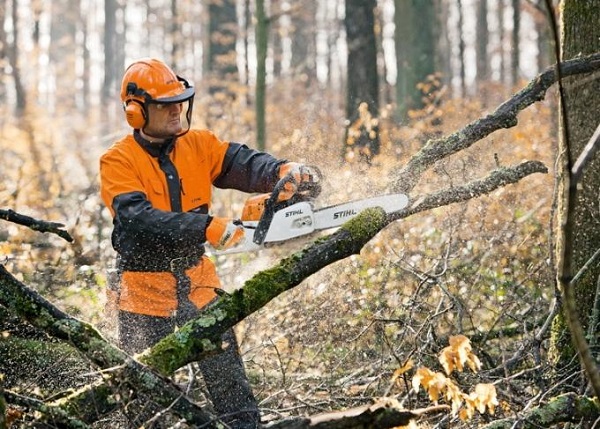
Domestic chainsaws, such as Ural, Friendship, developed back in Soviet times, 3–4 full tanks are depleted at idle speed in order to reach full capacity and run-in. Only then can you cut at partial load to about 5–7 full tanks. Only after such a rather thorough and expensive procedure is it possible to reach their maximum power.
To prepare the chain for the first run and run-in, you need to dip it completely in the oil for a couple of hours. Next, install it on the unit and stretch it so that the chain is turned by hand, but also not hanging down. Then the first start is made, and after 3-5 minutes of work, the tension is checked.

The saw tire does not need special preparation and running-in, it is enough to properly install, tension and prepare the chain itself, and, of course, the engine.
If you correctly break in a new chainsaw, then it will serve its owner for a long time without any problems and emergency downtime.

/rating_off.png)








